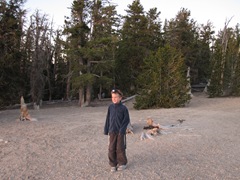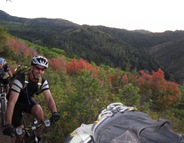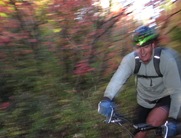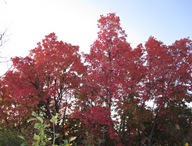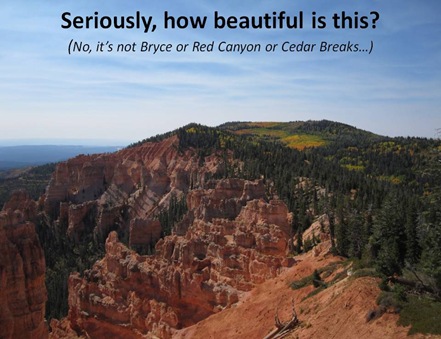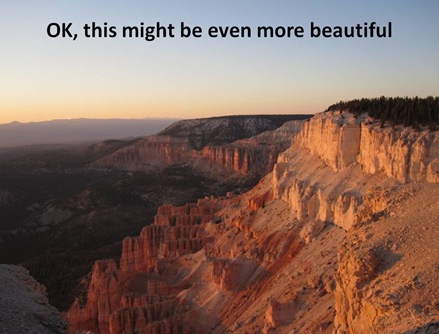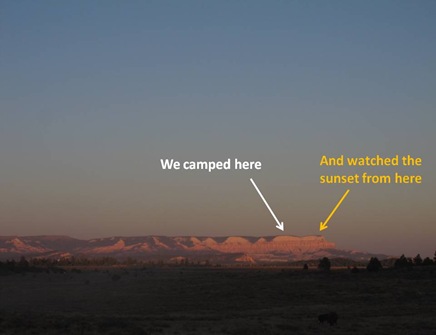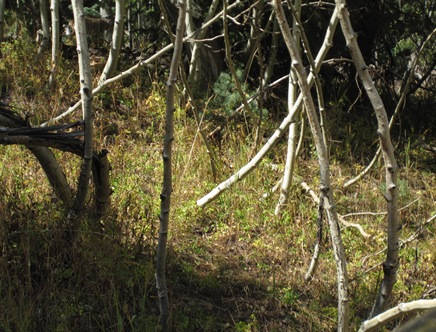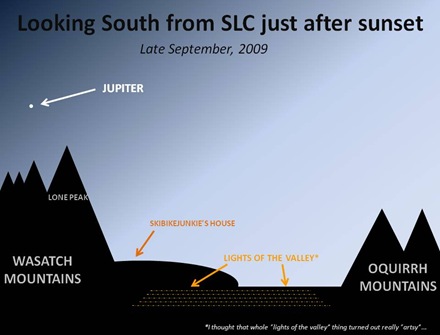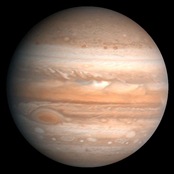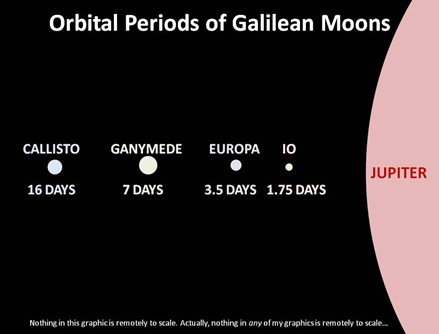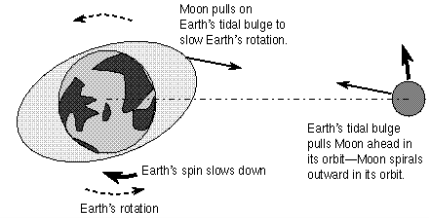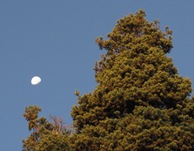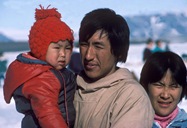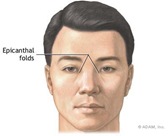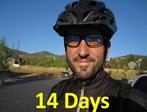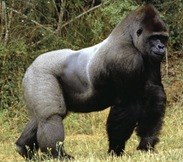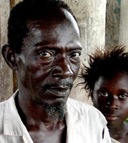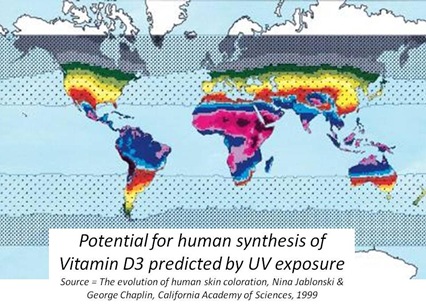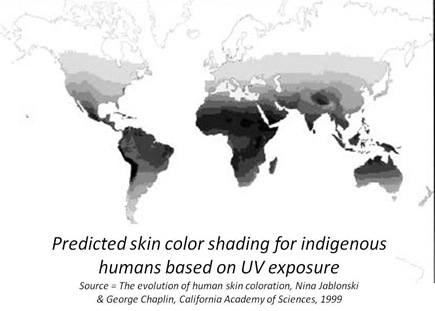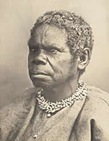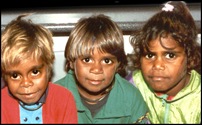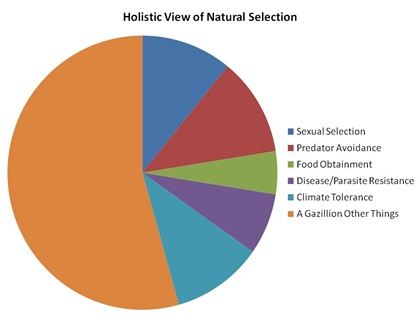I love the high Southern plateaus*- they’re full of beauty and mystery, spectacular geology, abundant wildlife, the most varied and interesting forests in the state, and thousands of wonderful hidden places. So Friday afternoon, when Awesome Wife dropped Bird Whisperer off at the office, we headed South.
*What is the plural of “plateau” anyway? I started out with “plateaux”, but the spell-checker kicked it back. I was going to ignore it and use the “x” anyway, but then I started feeling all self-conscious and Francophilish…
A couple of weeks ago when I blogged about Twin A and the Henry Mountains, I talked about how AW and I are trying to make sure we spend 1-on-1 time with each member of the Trifecta. My trip South with BW was part of that ongoing effort, but if anything it had just a bit more urgency.
Thinking Ahead
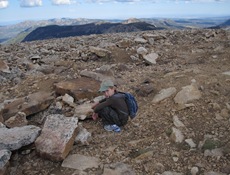 BW turned 10 this year, and though he’s bright and loving and kind and responsible and pretty much everything you’d ever hope your kid would be, this past year I’ve picked up a vibe from him that wasn’t there before. A vibe of interests directed away from us, a sense that his Dad just might not always be the most interesting and fascinating thing in his life. That the focus of his life will soon roam outside the family, to things social, to friends, and eventually girls and more.
BW turned 10 this year, and though he’s bright and loving and kind and responsible and pretty much everything you’d ever hope your kid would be, this past year I’ve picked up a vibe from him that wasn’t there before. A vibe of interests directed away from us, a sense that his Dad just might not always be the most interesting and fascinating thing in his life. That the focus of his life will soon roam outside the family, to things social, to friends, and eventually girls and more.
And as I thought about this sense, I realized that what I’ve been picking up on are the first early, pre-hints of adolescence. 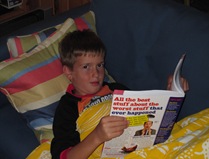 Soon his expanding perspective will be washed over by a cresting wave of hormones that’ll change how he sees and feels about everything: friends, girls, school, the world, and his parents. Thinking about all this made me think back about my own adolescence, and I realized that I largely “checked out” on my parents for several years in my teens and early twenties. I didn’t dislike them or anything; I just wasn’t particularly interested in them. Later, much later, I started noticing them again, and in a sense, like most kids when they finally grow up, came back home.
Soon his expanding perspective will be washed over by a cresting wave of hormones that’ll change how he sees and feels about everything: friends, girls, school, the world, and his parents. Thinking about all this made me think back about my own adolescence, and I realized that I largely “checked out” on my parents for several years in my teens and early twenties. I didn’t dislike them or anything; I just wasn’t particularly interested in them. Later, much later, I started noticing them again, and in a sense, like most kids when they finally grow up, came back home.
BW is so like I was in mood and temperament; I suspect he’ll check out the same way. So my kid is leaving soon for about a decade, and I want to spend time with him while he’s still “here”.
Tangent: BW is in 5th grade. I remember 5th and 6th grade as being sort of a proto-adolescence, where awkward things happened that you hoped were just kind of one-off deals, but which in fact turned out to be harbingers of the long dark age of junior high school just ahead… One of the examples that comes to mind was the whole “getting picked” thing, and specifically “getting picked last.” Getting picked last for teams in gym class, and even getting picked last when it was “ladies choice” in 6th grade dance class. Ouch. I went home hoping it was a 1-time occurrence but in fact it was the beginning of a several-year-long stretch* during which I was consistently and spectacularly unsuccessful with girls.
*Actually one could argue that it lasted nearly 20 years, until I talked Awesome Wife into going out with me.
Nested Tangent: My Mom signed me up for dance class, where we learned, you know, the waltz and the foxtrot and all, because well certainly those were important skills we’d need later in life. What a phenomenal waste of time that was; I learned absolutely nothing. Once every few years I go to a wedding or something where you’re expected to do a traditional-type dance and I just fake it and shuffle around smiling, like I assume everyone under 60 does. Sometimes though, you end up having to dance with an actual Old Person- like the bride’s great-aunt or something- and you get totally busted.
Do they still “pick” for teams in elementary school gym class? Christ, I hope not. I’ll ask my kids.
Back to the Paunsaugunt
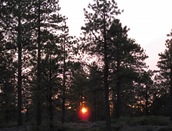 We drove down I-15 past Beaver, then cut over the hills to the Sevier River Valley and upstream through Panguitch before turning East up and onto the Paunsaugunt Plateau. I’ve been here many times, and we followed a back road I knew well into the forest, where we set up camp for the night amid the Ponderosas.
We drove down I-15 past Beaver, then cut over the hills to the Sevier River Valley and upstream through Panguitch before turning East up and onto the Paunsaugunt Plateau. I’ve been here many times, and we followed a back road I knew well into the forest, where we set up camp for the night amid the Ponderosas.
 Tangent: Here’s something I noticed on the drive down. You know how Harleys often have those big American flags flying off the back? What’s up with that? Why the need to identify their citizenship? Maybe I’m jumping to conclusions, but when I see a fat middle-aged white guy on a Harley riding down I-15, I generally already assume he’s a US citizen. Now, if he were a foreigner, visiting this country, then I could totally see him flying his German or Canadian or French flag or whatever. It’d be like, “Hey, check me out, I’m from France!”
Tangent: Here’s something I noticed on the drive down. You know how Harleys often have those big American flags flying off the back? What’s up with that? Why the need to identify their citizenship? Maybe I’m jumping to conclusions, but when I see a fat middle-aged white guy on a Harley riding down I-15, I generally already assume he’s a US citizen. Now, if he were a foreigner, visiting this country, then I could totally see him flying his German or Canadian or French flag or whatever. It’d be like, “Hey, check me out, I’m from France!”
Or maybe it’s some “patriotic” thing, where they’re flying the flag because you know, they’re “Keeping America Free” and what-not by uh… riding their motorcycles on I-15. I used to wonder if it was a Vietnam veteran thing, but most Harley riders nowadays don’t look much older than me, and I was 11 when Saigon fell.
Now if they flew those big flags when they rode their Harleys outside of the US, say in Canada, or better yet Mexico, then that would show some real national pride and courage, but then that would require actual cojones, and not just poser-jingoism…
We took turns reading aloud to each other until we went to sleep. BW’s book choice was Diary of Wimpy Kid, which he loves and I ended up enjoying as well.
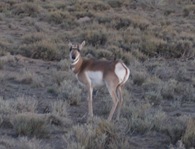 Last year I took the whole family down to the Paunsaugunt, and did a 3-part series about the plateau that covered Pronghorns*, Bristlecone Pines and endemic wildflowers. We had a great time, and explored further South on the plateau than I had previously. But when we turned home I was left wanting more. I wanted to see what lay further South, down to the very end of the Paunsaugunt. So when we rose and broke camp the next morning, we turned down Forest Road 087, South past Tropic reservoir, past Badger Creek (where we camped last year) and continued South.
Last year I took the whole family down to the Paunsaugunt, and did a 3-part series about the plateau that covered Pronghorns*, Bristlecone Pines and endemic wildflowers. We had a great time, and explored further South on the plateau than I had previously. But when we turned home I was left wanting more. I wanted to see what lay further South, down to the very end of the Paunsaugunt. So when we rose and broke camp the next morning, we turned down Forest Road 087, South past Tropic reservoir, past Badger Creek (where we camped last year) and continued South.
*Which we also saw plenty of this trip as well. (pic right)
Geology Is Way Cool
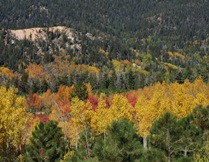 During the intervening year I’ve learned a lot more about the plateau, including the story behind its fascinating geology. Roughly 55 million years ago, a large lake, called Lake Claron, which was about the size of Lake Erie, covered a large chunk of what is now Southwest Utah. Over a few million years the lake deposited a series of sediments. The lake was intermittent, and in between inundations the exposed sediment-plains supported plant life, and much of the iron in the deposits oxidized, giving them pink and reddish hues.
During the intervening year I’ve learned a lot more about the plateau, including the story behind its fascinating geology. Roughly 55 million years ago, a large lake, called Lake Claron, which was about the size of Lake Erie, covered a large chunk of what is now Southwest Utah. Over a few million years the lake deposited a series of sediments. The lake was intermittent, and in between inundations the exposed sediment-plains supported plant life, and much of the iron in the deposits oxidized, giving them pink and reddish hues.
 About 34 million years ago, a series of volcanic eruptions occurred on and off for the next 3 million years or so. These eruptions, followed by later eruptions around 20 and again 7 million years ago, capped the sediments with layers of volcanic rock.
About 34 million years ago, a series of volcanic eruptions occurred on and off for the next 3 million years or so. These eruptions, followed by later eruptions around 20 and again 7 million years ago, capped the sediments with layers of volcanic rock.
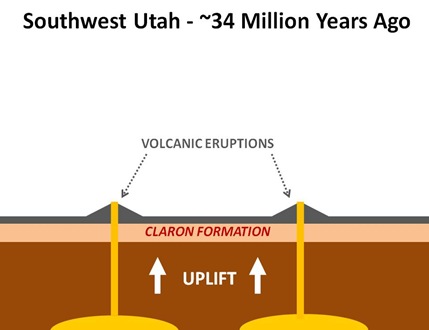 During this time, the land was rising, part of the gradual uplift of the Colorado Plateau as a whole. But the uplift wasn’t even; the land was broken up by faults in the Earth’s crust, and as the land rose, these faults divided and tilted the land into 3 distinct plateaus: the Markagunt (lying between the Hurricane fault by Cedar City and the Sevier Fault in Panguitch) the Paunsaugunt (lying between the Sevier Fault and the Paunaugunt Fault East of Bryce) and the Aquarius Plateau (to the Northeast of the Paunsaugunt Fault.)
During this time, the land was rising, part of the gradual uplift of the Colorado Plateau as a whole. But the uplift wasn’t even; the land was broken up by faults in the Earth’s crust, and as the land rose, these faults divided and tilted the land into 3 distinct plateaus: the Markagunt (lying between the Hurricane fault by Cedar City and the Sevier Fault in Panguitch) the Paunsaugunt (lying between the Sevier Fault and the Paunaugunt Fault East of Bryce) and the Aquarius Plateau (to the Northeast of the Paunsaugunt Fault.)
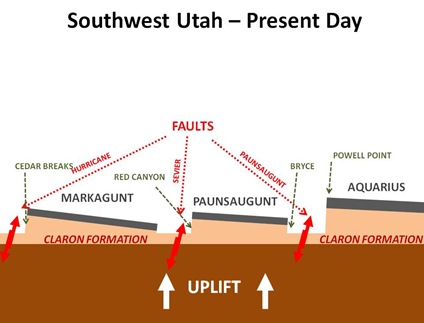 Around the steeper, faulted edges of these plateaus, the Claron sediments have been exposed, and over the past few million years runoff, wind, rain and frost have cracked and carved the exposed layers into the spectacular forms you see today in places like Bryce and Cedar Breaks.
Around the steeper, faulted edges of these plateaus, the Claron sediments have been exposed, and over the past few million years runoff, wind, rain and frost have cracked and carved the exposed layers into the spectacular forms you see today in places like Bryce and Cedar Breaks.
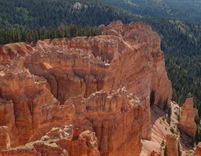 But the incredible cliffs and hoodoos aren’t limited to National Parks. Throughout the plateaus, smaller amphitheatres pop out all over the place, such as those by our Badger Creek campsite from last year, and the wonderful Pink Cliffs along the Virgin Rim trail.
But the incredible cliffs and hoodoos aren’t limited to National Parks. Throughout the plateaus, smaller amphitheatres pop out all over the place, such as those by our Badger Creek campsite from last year, and the wonderful Pink Cliffs along the Virgin Rim trail.
Geo-Tangent: We didn’t visit the Markagunt this past weekend, nor, more regrettably, at all this summer. It’s an amazing place, with fascinating geology and hydrology I hope to cover in future posts.
For mtn bikers, if you ever raced the now-(sadly)-defunct Brian Head Epic100, that course provided a fabulous geologic overview of the Markagunt.
And from hours poring over Google Maps, I was pretty sure I’d spotted similar amphitheatres along the South rim- the very end- of the plateau. It was these that I wanted to see.
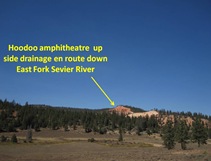 As we continued South along FR 087, we paralleled the East Fork of the Sevier River through a series of open meadows, one leading into the next. Every few miles a canyon would open up to the West- Skunk Creek, Blubber Creek, Kanab Creek, each one providing glimpses of hoodoos and amphitheatres- dozens of “mini-Bryces”- carved out of exposed hillsides (pic right). As we drove, BW read aloud, continuing our book from the night before.
As we continued South along FR 087, we paralleled the East Fork of the Sevier River through a series of open meadows, one leading into the next. Every few miles a canyon would open up to the West- Skunk Creek, Blubber Creek, Kanab Creek, each one providing glimpses of hoodoos and amphitheatres- dozens of “mini-Bryces”- carved out of exposed hillsides (pic right). As we drove, BW read aloud, continuing our book from the night before.
Finally we reached Crawford Pass, on the edge of the plateau. It’s forested here and hard to get one’s bearings, so we turned West and up, following a rougher jeep road. We climbed and wound our way through gorgeous Aspen groves, higher and higher, gradually making our way to the edge of the plateau. After 2 ½ more miles, the road reached a spot where it was bounded by a low, red-dirt slope, where a sign with binoculars was planted. We parked and scrambled 20 feet up to the top of the little slope. This is what we saw.
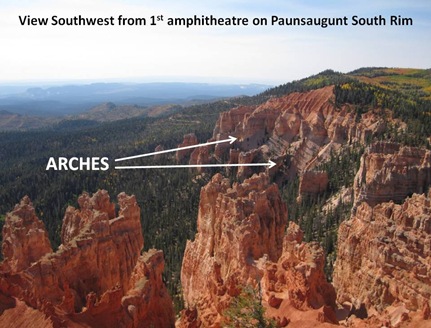 We grabbed a pack with lunch, a camera and binoculars and picked our way up to the high point of the ridge (pic left). The scene below us, through smaller in scope than Bryce, was every bit as spectacular as
We grabbed a pack with lunch, a camera and binoculars and picked our way up to the high point of the ridge (pic left). The scene below us, through smaller in scope than Bryce, was every bit as spectacular as 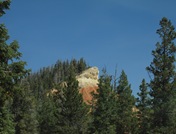 anything found in the national park, and we had it all to ourselves. In fact it was more spectacular; the rim at Bryce is bounded by uniform coniferous forests, but here the rim is cloaked in Aspen, which this weekend were decked in shades of yellow, green, red, orange and everything in between. And we perched at the very end of the Plateau; beyond us the land fell away and rolled off into an endless hazy distance of woodlands and deserts. It felt like the end of the world.
anything found in the national park, and we had it all to ourselves. In fact it was more spectacular; the rim at Bryce is bounded by uniform coniferous forests, but here the rim is cloaked in Aspen, which this weekend were decked in shades of yellow, green, red, orange and everything in between. And we perched at the very end of the Plateau; beyond us the land fell away and rolled off into an endless hazy distance of woodlands and deserts. It felt like the end of the world.
 We talked and pointed out weird rocks and hidden arches to each other while we munched P&J sandwiches. After a while our conversation drifted back to the book we’d been reading, and BW mentioned how sometimes his school has authors visit, and he wished they’d invite the author of Diary of a Wimpy Kid. He said, “It must be hard for him to write a book like that, because he has to get inside the head of a kid…”
We talked and pointed out weird rocks and hidden arches to each other while we munched P&J sandwiches. After a while our conversation drifted back to the book we’d been reading, and BW mentioned how sometimes his school has authors visit, and he wished they’d invite the author of Diary of a Wimpy Kid. He said, “It must be hard for him to write a book like that, because he has to get inside the head of a kid…”
Say what? When did my little boy start talking like that? It’s like I looked away for a moment and he grew up…
From our perch we spied another amphitheatre another couple of miles West along the rim, so we picked our way back down, and then continued driving.
Side Note: The “picking our way along the rim” was far and away the most exposed/hazardous part of this adventure. If you do this with small kids, supervise them closely.
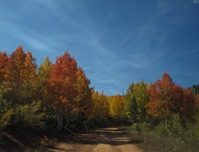 We drove slowly over rough road another mile or to before turning left onto a side road marked “PINK CLIFFS”. The road bent slowly around a hill, then climbed. BW was looking down at his book, and I was looking straight ahead, when 40 feet in front us, a Bobcat popped out and stopped in the road.
We drove slowly over rough road another mile or to before turning left onto a side road marked “PINK CLIFFS”. The road bent slowly around a hill, then climbed. BW was looking down at his book, and I was looking straight ahead, when 40 feet in front us, a Bobcat popped out and stopped in the road.
All About Bobcats
I’ve spotted Cougars twice, but this was my first clear Bobcat sighting. When you first see a cougar, you generally have the following reaction. Your brain says: DOG. But a fraction of a second later, you know that something’s wrong with this “dog”- usually either with its tail or its muzzle, and then you realize what it is.
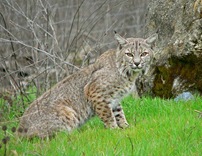 When you see a Bobcat (pic left, not mine), there’s no such confusion. Your brain immediately says: CAT. A fraction of a second later there’s a similar “something’s wrong” feeling, but it’s that the cat is so damn big- it’s like your housecat pulled an Incredible Hulk or something.
When you see a Bobcat (pic left, not mine), there’s no such confusion. Your brain immediately says: CAT. A fraction of a second later there’s a similar “something’s wrong” feeling, but it’s that the cat is so damn big- it’s like your housecat pulled an Incredible Hulk or something.
There’s a tendency to think of Bobcats and Cougars in the same way, but they’re quite different. While Cougars regularly hunt deer, rabbits and hares are the staple of Bobcats. A desperate (or opportunistic ) Bobcat may take down a deer, but it’s more the exception than the rule*. They’re also, if anything, less of a threat to humans than Cougars. Though attacks on humans do occasionally occur, I couldn’t find a record of any resulting (human) fatalities. Another big difference between Bobcats and Cougars is that Bobcats are relative newcomers to North America. Not nearly as recent as Grizzlies, Wolves, Moose or Bison, but much more recent than Cougars, whose ancestors have been around here for some 8 million years.
*Interestingly, Bobcats also regularly (successfully) hunt Porcupines, which they kill by attacking the nose/snout.
 Lynxes evolved in Africa several million years ago. They spread throughout the Old World and diversified into various species, 2 of which live on today: the widespread Eurasian Lynx, Lynx lynx, and the now rare and endangered Iberian Lynx, L. pardinus. For a long time biologists believed that a group of Eurasian lynxes arrived in North America a few million years ago, and then diverged into Bobcats, L. rufus, and Canadian Lynxes, L. canadensis (pic right, not mine), but both genetic and fossil evidence now suggest otherwise. Instead it now appears that a first group of Eurasian lynx migrated to North America via Beringia between 3 and 5 million years ago, and that this group gave rise to modern Bobcats.
Lynxes evolved in Africa several million years ago. They spread throughout the Old World and diversified into various species, 2 of which live on today: the widespread Eurasian Lynx, Lynx lynx, and the now rare and endangered Iberian Lynx, L. pardinus. For a long time biologists believed that a group of Eurasian lynxes arrived in North America a few million years ago, and then diverged into Bobcats, L. rufus, and Canadian Lynxes, L. canadensis (pic right, not mine), but both genetic and fossil evidence now suggest otherwise. Instead it now appears that a first group of Eurasian lynx migrated to North America via Beringia between 3 and 5 million years ago, and that this group gave rise to modern Bobcats.
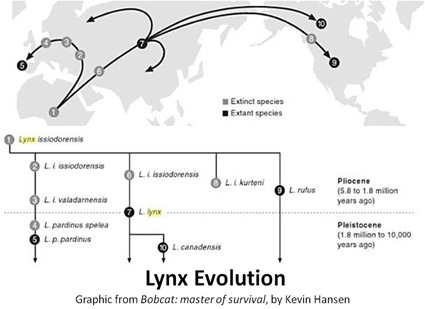 Much later, probably around 1 million years ago, another group came across the land-bridge, and this second group were the ancestors of Canada Lynx.
Much later, probably around 1 million years ago, another group came across the land-bridge, and this second group were the ancestors of Canada Lynx.
Tangent: This “double migration” story, where some animal migrated over to North America on multiple, widely (temporally) spaced occasions, is a story we’ve heard before, most recently with Bison. A similar- though much shorter timescale- multiple-migration happened more recently with humans. Native Americans are thought to have entered North America in 2 or 3 distinct waves*, and the Inuit were a still later, completely different migration.
Multiple migrations are of course routine in the plant kingdom, particularly with weeds. Cheatgrass in North America is believed to be descended from 7 or 8 “successful” introductions, and Dandelions…. well, too many to count.
*Like just about everything to do with the nature and timing of the arrival of humans in the Americas, this is both uncertain and highly controversial. Research on the topic has long focused on linguistics, and more recently genetics.
So Bobcats and Canada Lynx aren’t quite as closely-related as once thought, but they’re still closely-related enough to interbreed and produce fertile hybrids, which they occasionally do where their ranges overlap (Northern US, Southern Canada.) Lynx are usually larger than Bobcats, though the largest Bobcats are bigger than the smallest lynxes.
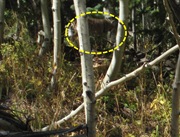 Bobcats, like Cougars, tend to be active around dawn and dusk, and so our sighting- at around 12:30PM- surprised me. When we returned home I read up on them and it turns out that in the Fall and Winter they start to get more active by day, probably because their prey becomes more diurnally-active as well in the colder months.
Bobcats, like Cougars, tend to be active around dawn and dusk, and so our sighting- at around 12:30PM- surprised me. When we returned home I read up on them and it turns out that in the Fall and Winter they start to get more active by day, probably because their prey becomes more diurnally-active as well in the colder months.
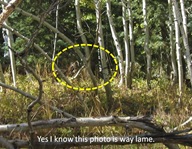 I yanked the emergency brake and yelled at BW to look up. The Bobcat bounded into the woods, but BW quickly caught sight of it with an exclamation of glee. I grabbed the camera off the passenger seat and leapt out- I’d missed the bear in Montana, I was not missing this shot. I snapped several, none of which came out well, but hey, at least I got it. The Bobcat stopped and started a couple of times while I snapped these pics. BW got a good look at him and was thrilled, pronouncing this, “the best wildlife day of my life!” The trip was a success. Anything else was gravy.
I yanked the emergency brake and yelled at BW to look up. The Bobcat bounded into the woods, but BW quickly caught sight of it with an exclamation of glee. I grabbed the camera off the passenger seat and leapt out- I’d missed the bear in Montana, I was not missing this shot. I snapped several, none of which came out well, but hey, at least I got it. The Bobcat stopped and started a couple of times while I snapped these pics. BW got a good look at him and was thrilled, pronouncing this, “the best wildlife day of my life!” The trip was a success. Anything else was gravy.
We continued to the next overlook and were greeted with another spectacular amphitheatre full of pink cliffs and hoodoos. As we looked West we could see several more, stretched out over several miles along the Southern rim of the plateau. You could spend days here, exploring one amazing hoodoo-fairyland after another, maybe seeing no one else for days at a time.
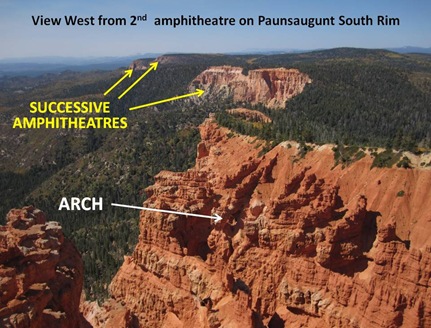 But our time was limited. We turned around headed back the way we came, bound for the next plateau.
But our time was limited. We turned around headed back the way we came, bound for the next plateau.
Next Up: Aquarius- it’s not just that corny song from the 60’s musical they made you sing in music class- it’s also a plateau.
